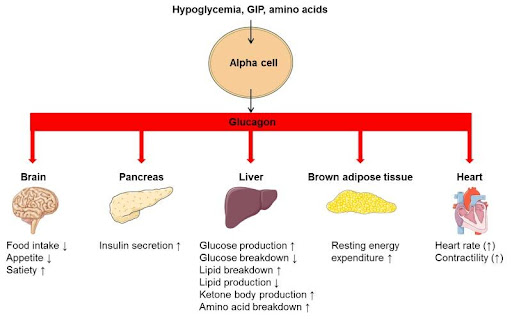Role of Glucagon
Anwardeen Sirajuddin*
Clinical Pharmacist-CST, Kauvery Hospitals, India
*Correspondence: +91 9578038232; clinical.cst@kauveryhospital.com
Background
Glucagon, the main insulin-regulatory hormone, is the first-line treatment for severe hypoglycemia in insulin-treated diabetic patients [1].
Glucagon is a glucoregulatory peptide hormone that stimulates hepatic glucose production and thus raises blood glucose levels by counteracting the actions of insulin.
Furthermore, glucagon mediates a number of non-glucose metabolic effects that are critical for maintaining whole-body energy balance in times of limited nutrient supply [2].
Glucagon is important in the pathophysiology of diabetes because high levels of glucagon in these patients stimulate hepatic glucose production, contributing to diabetic hyperglycemia [2].
Physiological Function of Glucagon
-
- Regulations of glucose metabolism: glucagon acts in opposition to insulin which facilitates metabolism of glucose and lowers blood glucose levels. Glucagon promotes the release of glucose from the liver into the bloodstream (Fig.1). This is achieved by stimulating the breakdown of glycogen, a stored from of glucose in the liver, and by promoting the production of glucose from amino acids.
- Regulations of lipid metabolism: In addition to regulating glucose metabolism glucagon plays a role in lipid metabolism It promotes the breakdown of triglycerides stored in adipose tissue, releasing fatty acids into the bloodstream for use as an energy source (Fig. 1).
- Regulation of protein metabolism: Glucagon stimulates the breakdown of proteins in muscle tissue, providing amino acids that can be used for gluconeogenesis or energy production

Fig. 1. Organ Specific Actions of Glucagon.
Mechanism of Action
Glucagon binds to specific receptors on target cells activating a signalling cascade that leads to its physiological effects. The primary target of glucagon is the liver where it binds to receptors on the surface of hepatocytes. This binding activates the enzyme adenylate cyclase, which in turn increase the production of cyclic adenosine monophosphate (cAMP). cyclic adenosine monophosphate then activates protein kinase A (PKA), which promotes the breakdown of glycogen and the production of glucose
Potential Therapeutic Applications
-
-
- Diabetes: Glucagon has been used as a treatment for severe hypoglycaemia, a condition in which blood glucose levels drop dangerously low in people with diabetes who are taking Insulin. Glucagon can also be used in combination with insulin to manage blood glucose levels in people with type 1 & 2 diabetes
- Obesity: Glucagon receptor agonists have been developed as a potential treatment for obesity. These drugs mimic the effects of glucagon promoting the breakdown of stored fat and reducing food intake
- Liver disease: Glucagon has been studied as a potential treatment for non-alcoholic fatty liver disease (NAFLD), a condition in which excess fat accumulates in the liver. Glucagon promotes the breakdown of stored fat in the liver, reducing the accumulation of fat and improving liver function.
-
Antidote of Glucagon
Beta blockers are medication that are commonly used to treat conditions such as hypertension and heart disease. In the event of a beta blockers overdose, the heart rate and blood pressure can become dangerously low, which can lead to severe complications or even death. In such cases, glucagon can be used as a treatment option to counteract the effects of the beta blockers. Glucagon works by increasing the level of cyclic cAMP in the heart muscle cells which can help to increase heart rate and improve cardiac output. This can help to stabilize blood pressure and improve blood flow to vital organs. However, it is important to note that the use of glucagon in beta blocker overdose is not always effective and other treatments may be necessary depending on the severity of the overdose and the specific symptoms present
Conclusion
Glucagon is a critical hormone that plays a vital role in regulating glucose, lipid and protein metabolism. Its mechanism of action is well understood and its potential therapeutic applications are being explores in a range of conditions including diabetes, obesity and liver disease
References
-
-
-
- Nitil Kedia. Treatment of severe diabetic hypoglycemia with glucagon: an underutilized therapeutic approach. Diabetes Metab Syndr Obes. 2011;4:337-346.
- Rix I, et al. Glucagon Physiology. In: Feingold KR, et al., editors. Endotext. South Dartmouth (MA): MDText.com, Inc. 2000.
- https://mdpoison.com/media/SOP/mdpoisoncom/healthcareprofessionals/antidote-facts/Glucagon%20Antidote%20Facts.pdf
- Kerns W 2nd. Management of beta-adrenergic blocker and calcium channel antagonist toxicity. Emerg Med Clin North Am. 2007;25(2):309-31.
- Shepherd, G. (2006). Treatment of poisoning caused by -adrenergic and calcium-channel blockers. American Journal of Health-System Pharmacy, 63(19),1828-1835.
-
-

Anwardeen Sirajuddin
Clinical Pharmacist-CST
